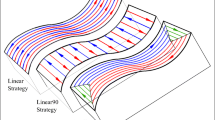Abstract
Convex and concave inclined surfaces are frequently encountered in the machining of components in industries such as aerospace, aircraft, automotive, biomedical, and precision machinery manufacturing and mold industries. Tool path styles, generated by different cutting strategies, result in various cutting forces and tool deflection values that might lead to poor surface integrities. In cost-effective manufacturing, it is helpful to make known their effects on machinability. Thus, the first aim of this study is to investigate optimum cutting parameter values in ball end milling of EN X40CrMoV5-1 tool steel with three coated cutters. The parameters taken into consideration are cutting speed, feed rate, step over, and tool path style. The second aim of the study is to determine the effects of tool path styles in ball end milling of inclined surfaces. As a result, the most effective parameter within the selected cutting parameters and cutting styles for both inclined surfaces and different coatings was step over. In terms of tool coatings, the most rapidly deteriorating coating was TiC coating for cutting forces in both inclined surfaces and for tool deflection in convex inclined surface. In addition, the response surface methodology is employed to predict surface roughness values, depending on the cutting forces obtained. The model generated gives highly accurate results.
Similar content being viewed by others
References
Gok A, Gologlu C, Demirci HI, Kurt M (2012) Determination of surface qualities on inclined surface machining with acoustic sound pressure. Strojniški vestnik-Journal of Mechanical Engineering 58–10:587–597
Shaw MC (2005) Metal cutting principles, 2nd edn. Oxford University Press, Oxford
Trent EM, Wright P (2000) Metal cutting, 4th edn. Butterworths, London
Zhou JM, Andersson M, Ståhl JE (2004) Identification of cutting errors in precision hard turning process. J Mater Process Technol 153–154:746–750
Gologlu C, Sakarya N (2008) The effects of cutter path strategies on surface roughness of pocket milling of 1.2738 steel based on Taguchi method. J Mater Process Technol 206:7–15
Yang JL, Chen JC (2001) A systematic approach for identifying optimum surface roughness performance in end-milling operations. J Ind Technol 17(2):1–8
Yang WH, Tarng YS (1998) Design optimization of cutting parameters for turning operations based on the Taguchi method. J Mater Process Technol 84:122–129
Kurt M, Bagci E, Kaynak Y (2009) Application of Taguchi methods in the optimization of cutting parameters for surface finish and hole diameter accuracy in dry drilling processes. Int J Adv Manuf Technol 40:458–469
Abrari F, Elbestawi MA (1997) Closed form formulation of cutting forces for ball and flat end mills. Int J Mach Tools Manuf 33:17–27
Huang T, Whitehouse DJ (1999) Cutting force formulation of taper end mills using differential geometry. Precis Eng 23:196–203
Shatla M, Altan T (2000) Analytical modeling of drilling and ball end milling. J Mater Process Technol 98:125–133
Ikua BW, Tanaka H, Obata F, Sakamoto S (2001) Prediction of cutting forces and machining error in ball end milling of curved surfaces—I: theoretical analysis. Precis Eng 25:266–273
Kim GM, Kim BH, Chu CN (2003) Estimation of cutter deflection and form error in ball end milling processes. Machine Tools & Manufacture 43:917–924
Ikua BW, Tanaka H, Obata F, Sakamoto S, Kishi T, Ishii T (2002) Prediction of cutting forces and machining error in ball end milling of curved surfaces—II: experimental verification. Precis Eng 26:69–82
Lacalle LNL, Lamikiz A, Sanchez JA, Salgado MA (2004) Effects of tool deflection in the high-speed milling of inclined surfaces. Int J Adv Manuf Technol 24:621–631
Ryu S, Lee H, Chu N (2003) The form error prediction in side wall machining considering tool deflection. Int J Mach Tool Manuf 43:1405–1411
Rao VS, Rao PVM (2006) Tool deflection compensation in peripheral milling of curved geometries. International Journal Of Machine Tools & Manufacture 46:2036–2043
Aoyama H, Ishii T (2004) Sensor to detect cutting force components, cutting torque, and cutting tool deflections. J Manuf Process 6(2):141–147
Depince P, Hascoet Y (2006) Active integration of tool deflection effects in end milling. Part 2. Compensation of tool deflection. Int J Mach Tool Manuf 46:945–956
Habibi M, Arezoo B, Nojedeh MV (2011) Tool deflection and geometrical error compensation by tool path modification. Int J Mach Tool Manuf 51:439–449
Subrahmanyam KVR, San WY, Soon HG, Sheng H (2010) Cutting force prediction for ball nose milling of inclined surface. Int J Adv Manuf Technol 48(1–4):23–32
Nicola GL, Missell FP, Zeilmann RP (2010) Surface quality in milling of hardened H13 steel. Int J Adv Manuf Technol 49(1–4):53–62
Piegl L, Tiller W (1997) The NURBS book, 2nd edn. Springer, Berlin
Trent EM (1989) Metal cutting. Butterworths, London
El-Tamimi AM, El-Hossainy TM (2008) Investigating the machinability of AISI 420 stainless steel using factorial design. Mater Manuf Process 23(4):419–426
Ozlu E, Budak E, Molinari A (1999) Analytical and experimental investigation of rake contact and friction behaviour in metal cutting. International Journal of Machine Tools & Manufature 49:865–875
Ding T, Zhang S, Wang Y, Zhu X (2010) Empirical models and optimal cutting parameters for cutting forces and surface roughness in hard milling of AISI H13 steel. Int J Adv Manuf Technol 51(1–4):45–55
Balta S (2007) Robust design of a breast scintigraphy collimator using Monte Carlo simulations and response surface methodology. Master’s thesis, Bogaziçi University, Istanbul, Turkey
Kadirgama K, Abou-El-Hossein KA, Mohammad B, AL-Ani H, Noor MM (2008) Cutting force prediction model by FEA and RSM when machining Hastelloy C-22HS with 90° holder. Journal of Scientific & Industrial Research 67:421–427
Montgomery DC (2000) Design and analysis of experiments. Wiley, New York
Ross PJ (1996) Taguchi techniques for quality engineering. McGraw-Hill, New York. ISBN 0-07-114663-6:1-73
Author information
Authors and Affiliations
Corresponding author
Rights and permissions
About this article
Cite this article
Gok, A., Gologlu, C. & Demirci, H.I. Cutting parameter and tool path style effects on cutting force and tool deflection in machining of convex and concave inclined surfaces. Int J Adv Manuf Technol 69, 1063–1078 (2013). https://doi.org/10.1007/s00170-013-5075-x
Received:
Accepted:
Published:
Issue Date:
DOI: https://doi.org/10.1007/s00170-013-5075-x




